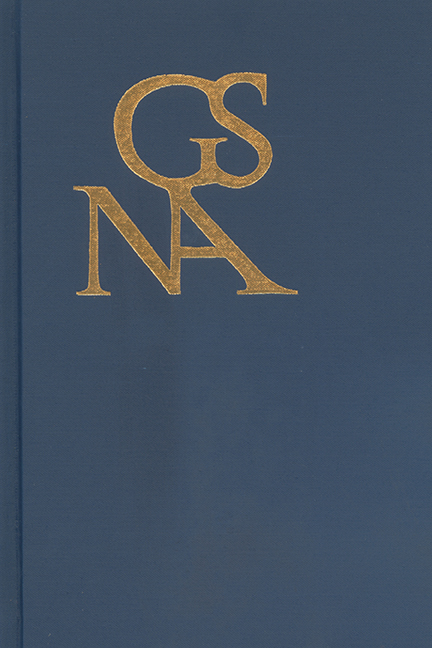Book contents
- Frontmatter
- Contents
- Building Bridges: Goethe's Fairy-Tale Aesthetics
- Goethe as Mystagogue
- Observing Neutrality, circa 1800
- Goethe, Faust, and Motherless Creations
- Impossible Ideals: Reconciling Virginity and Maternity in Goethe's Werther
- Kant, Calculus, Consciousness, and the Mathematical Infinite in Us
- The Classical Aesthetics of Schlegel's Lucinde
- Special Section on Visual Culture in the Goethezeit
- Acquaintance with Color: Prolegomena to a Study of Goethe's Zur Farbenlehre
- “Hamiltonian-Hendelian” Mimoplastics and Tableau of the Underworld: The Visual Aesthetics of Goethe's 1815 Proserpina Production
- J. W. Goethe and C. G. Carus: On the Representation of Nature in Science and Art
- Brentano's Remains: Visual and Verbal Bricolage in Gockel, Hinkel und Gackeleia (1838)
- A Book of Living Paintings: Tableaux Vivants in Goethe's Die Wahlverwandtschaften (1809)
- Book Reviews
Acquaintance with Color: Prolegomena to a Study of Goethe's Zur Farbenlehre
from Special Section on Visual Culture in the Goethezeit
Published online by Cambridge University Press: 25 February 2017
- Frontmatter
- Contents
- Building Bridges: Goethe's Fairy-Tale Aesthetics
- Goethe as Mystagogue
- Observing Neutrality, circa 1800
- Goethe, Faust, and Motherless Creations
- Impossible Ideals: Reconciling Virginity and Maternity in Goethe's Werther
- Kant, Calculus, Consciousness, and the Mathematical Infinite in Us
- The Classical Aesthetics of Schlegel's Lucinde
- Special Section on Visual Culture in the Goethezeit
- Acquaintance with Color: Prolegomena to a Study of Goethe's Zur Farbenlehre
- “Hamiltonian-Hendelian” Mimoplastics and Tableau of the Underworld: The Visual Aesthetics of Goethe's 1815 Proserpina Production
- J. W. Goethe and C. G. Carus: On the Representation of Nature in Science and Art
- Brentano's Remains: Visual and Verbal Bricolage in Gockel, Hinkel und Gackeleia (1838)
- A Book of Living Paintings: Tableaux Vivants in Goethe's Die Wahlverwandtschaften (1809)
- Book Reviews
Summary
Auch in Wissenschaften kann man eigentlich nichts wissen, es will immer getan sein.
—LA 1.9:268[In the sciences, too, there is actually nothing to know. It must always be done.]
WHAT TYPE OF OBJECT is the text Goethe entitled Zur Farbenlehre? Superficial appearances notwithstanding, the question does not already contain its own answer: it is uninformative simply to respond that Zur Farbenlehre is a text. Nor can an answer merely consist in an explanation of what the text is about. For in order to make authoritative statements about the text's purport, presuppositions have to be in place concerning its form. To give an example, the text calls itself at numerous junctures scientific, and how we understand this sort of discursive self-attribution is impacted by the form of the text at hand. Of course, a fuller articulation of the form of Zur Farbenlehre will unfold according to a great number of further distinctions, but it is clear that even the initial reading of a textual object entails certain framing assumptions and judgments about what sort of thing one is being confronted with. In the case of Goethe's text, our familiarity with the term Lehre can encourage the belief that we are dealing with the exposition of a collection, even a systematic elaboration, of abstract propositions. But that is, importantly, not what Goethe's text entails.
Indeed, a cursory glance at the text reveals that its procedure cannot be described as straightforwardly explanatory or justificatory. That is to say, Goethe's text does not just tell us what it is like for material objects to appear, nor is it in the business of justifying a stance concerning their reality. Perhaps most surprising, given our expectations of early modern science, Zur Farbenlehre never offers a physical definition of color or light in terms of either corpuscles or waves. Instead, it presents protocols for a seemingly countless number of experiments the reader is meant to conduct simultaneously with reading; it devotes a sizable section to aesthetic questions; and essentially half its pages develop a history of inquiry into color from archaic times to Goethe's own day.
- Type
- Chapter
- Information
- Goethe Yearbook 23 , pp. 143 - 170Publisher: Boydell & BrewerPrint publication year: 2016



